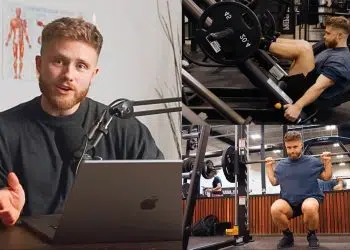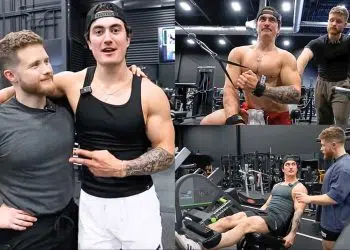The internet exposes us to vast stores of information on every subject. However, sometimes there is so much contradicting data that it is impossible to make the right decisions. Weight loss is one such topic. Many fad diets earn an extensive following due to their quick fat-loss results. Sadly, most fail in the long term. In his recent video, fitness expert Jeff Nippard addressed this problem and shared effective long-term fat-loss methods.
Nippard is a Canadian natural bodybuilder, powerlifter, and fitness influencer who runs a science-based fitness YouTube channel. He won the Mr. Junior Canada title in 2012 and set the Canadian national bench press record in 2014. Apart from years of coaching and training, Nippard’s knowledge comes from his bachelor of science degree in biochemistry. At the time of writing, his YouTube channel has over 3.5 million subscribers.

In the video posted on his YouTube channel on Jan. 23, 2023, Nippard discussed various reasons why most people gained back the lost weight and shared three long-term-focused strategies to avoid it.
Jeff Nippard explains the basics of fat loss
Nippard drew attention to the studies that suggest most fat-loss diets fail in the long term. He quoted a study that revealed all but one contestant in the show ‘The Biggest Loser’ gained their weight back within six years. A significant fraction of them gained more weight than they had lost during the show.
“Why this trend is so common is that people often don’t realize that they’re getting lean for a temporary time frame — a fitness event, a wedding, or a photo shoot — is a different goal with a different strategy than it is getting lean and staying lean for a long term,” Nippard explained.
Nippard starts with fat loss basics and explains caloric deficit, which includes burning more calories than you consume in a day. You burn calories in four ways:
Level Up Your Fitness: Join our 💪 strong community in Fitness Volt Newsletter. Get daily inspiration, expert-backed workouts, nutrition tips, the latest in strength sports, and the support you need to reach your goals. Subscribe for free!
- Resting Energy Expenditure: Calories burned during rest (Calculate RMR/REE)
- Exercise Activity Thermogenesis: Calories burned during exercise
- Non-Exercise Activity Thermogenesis (NEAT): Calories burned during day-to-day physical activities other than exercise (Try our TDEE calculator)
- Thermic Effect of Food: Calories burned while digesting food
Metabolic adaptation and the need to lower caloric intake with time
You are in a caloric deficit when you eat fewer calories in a given day than you burn through these four ways. On average, a 500-calorie deficit sustained over an extended period will help you lose approximately a pound of body weight every week, which is a reasonable target for most people. However, due to metabolic adaptation, you might need to lower the calories intake slightly to maintain the caloric deficit. Nippard explained the meaning of metabolic adaptation in detail and stated:
“As you lose weight, you won’t burn as many calories through resting energy expenditure because your body is getting smaller. You won’t burn as many calories per unit of exercise because your body is becoming more energetically efficient. You won’t burn as many calories through NEAT because your body is becoming less hyperactive and fidgety, and you won’t burn as many calories through the thermic effect of food because you’re eating less food.”
Nippard further explained that a sustained caloric deficit, weight training, and sufficient protein consumption (1.6 to 2.2 grams per kilogram of body weight) are the three most important factors in weight loss.
“From here, people turn to short-term strategies to try to get that fat off as quickly as possible, but this is a mistake. All the most popular fad diets will cause fat loss in the short term. That’s what actually caused them to become so popular in the first place. But the low-calorie crash diets tend to result in more muscle loss and eventual weight regain,” Nippard explained.
Nippard delved into other aspects of fad diets and stated that excluding a particular food group (e.g., dairy) could cause extreme cravings and deficiencies after a while and result in eventual weight gain. With that in mind, let’s explore Nippard’s three strategies for sustainable fat loss.
Jeff Nippard shares three strategies for long-term fat loss
Strategy 1: Diet More Slowly
According to Nippard, the first strategy is to diet more slowly — making small changes to your diet that are barely noticeable.
“The general science-based cutting rule is that you should aim to lose around 0.5 to 1 percent of your body weight in a fat loss phase. So if you weigh 200 pounds right now, you should try to lose 1 to 2 pounds per week. In other words, if you want to cut 20 pounds, it should take you 10 to 20 weeks to get there,” Nippard explained.
The Canadian recommends going at this pace. According to him, however, there are some benefits of losing fat even slower.
“I think this mindset is not only okay but actually smarter because it will help you not only be chill throughout the dieting process, it’ll help you stay chill once you get to your goal weight. By going slow, you won’t feel deprived or eager to get off the diet because you won’t feel like you’ve been dieting very hard all along,” He added.
Although this method will take a little bit longer to reach the desired weight, it will help maintain that weight. Nippard recommends maintaining a 20 percent caloric deficit — shedding 0.5 pounds or less per week. To calculate the maintenance level caloric intake, Nippard shared the following methods:
Method 1 (Faster Weight Loss)
Multiply your weight in pounds by 14-18.
- If you’re more active, you’ll be closer to bodyweight x 18 (or higher)
- In case you’re less active, you’ll be closer to bodyweight x 14 (or lower)
- If you’re not sure, bodyweight x 16 is usually reasonably accurate
View this post on InstagramGet Fitter, FasterLevel Up Your Fitness: Join our 💪 strong community in Fitness Volt Newsletter. Get daily inspiration, expert-backed workouts, nutrition tips, the latest in strength sports, and the support you need to reach your goals. Subscribe for free!
Method 2 (Slower Weight Loss)
Guess and Check: Track your body weight and caloric intake for two weeks. Calculate your average weight and average calories for week 1 and week 2. Determine the average weight gained or lost from week 1 to week 2. Find your maintenance based on the weight change. If you maintain your weight, your average calories are your estimated maintenance. If you lose 0.5 to 1 pound, your maintenance will be roughly 200-500 calories above your average. If you gain 0.5 to 1 pound, your maintenance will be approximately 0.5 to 1 pound below your average calories. Continue to guess and check for a few weeks until you find the intake at which you maintain your weight.
Nippard suggested making intuitive low-calorie food choices and tracking body weight for those who do not prefer tracking their calories.
“In addition to giving yourself plenty of time to get lean, you also need to give yourself a realistic end target. No matter how slow you go, you simply can’t expect to maintain six percent body fat all year around. At a certain point, your sleep, libido, energy, and mood will all plummet. All you’ll ever be able to think about is food,” Nippard cautioned.
As a general rule, Nippard suggests targeting 10 to 20 percent body fat for men and 18 to 28 percent body fat for women.
Strategy 2: Leverage habits
Nippard advises leveraging habits to make the diet feel easy. As much as we love motivation, it is short-term. Generally, motivation is at its peak when you start something new. It, however, wears down with time. Strong habits and discipline keep you going when motivation starts fading.
Nippard shared two science-based techniques for building strong habits:
- Temptation stacking: Combining your favorite activity with an activity that helps you achieve your fat loss goal (e.g., watching a movie while walking on a treadmill)
- Align your environment with your goals: Try to find an alternative to habits that get in the way of your fat loss goal (e.g., not buying foods that you overeat or replacing late-night stress eating with reading, puzzle solving, etc.)
Strategy 3: Have a smart post-diet plan
You need a proven maintenance diet plan to keep away the lost weight. You will reach the target weight within a few weeks to a few months, but you have to maintain that target weight for the rest of your life.
Nippard noted that most people do not have a post-diet plan. On the other hand, some adopt a meticulous reverse diet plan. In both cases, the weight starts creeping back up until it returns to square one.
To avoid this, Nippard advises switching to a maintenance caloric intake immediately after reaching your goal weight.
“If you no longer have the goal of losing weight, why be in a caloric deficit? You’re not cutting anymore. You should get to maintenance and get on with your new goal of maintaining.”
Ideal maintenance caloric intake
According to Nippard, finding your maintenance caloric intake can be difficult and may need trial and error. However, in most cases, it is 200 to 600 calories above your caloric intake at the end of the cut. For example, if you ate 2,000 calories at the end of your cut, you should jump to 2,600 calories.
“From there, you should gradually increase your calories until you get them as high as possible while still maintaining your body weight on average.”
“You should think of your maintenance as a dynamic range meaning you might be able to maintain your weight by eating anything from 2,600 to 3,000 calories. So over time, you should try to increase your calories towards the top end of your maintenance calorie range.”
This method has nothing to do with metabolism, science, or performance. There is one reason and one reason only to adopt this — if you can eat more food, it will make it easier for you to maintain your weight. Additionally, more food will also help improve your performance, especially if you’re planning to get into a lean gaining phase.
Nippard’s strategies are backed by thorough research and years of experience. The quick weight loss methods are more suitable for fitness, entertainment, and sports industry professionals. However, sustained and gradual fat loss is the way to go for most of us. So if you have decided to lose all that extra fat this year, go ahead and try Nippard’s strategies.
You can watch the full video below, courtesy of Jeff Nippard’s YouTube channel:











